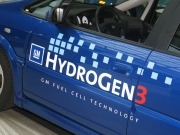
The European Union (EU) has launched a new research project called SusFuelCat (Sustainable fuel production by aqueous phase reforming - understanding catalysis and hydrothermal stability of carbon supported noble metals) supported by a funding budget of €3.5 million over the next four years. The project will investigate how to improve the production of hydrogen fuel from wet biomass using the process of catalytic reforming in an aqueous solution, also known as Aqueous Phase Reforming (APR). The technique offers substantial benefits for the renewable energy sector because of its high level of energy efficiency.
At present, hydrogen can only be extracted from biomass using large amounts of energy. Wet biomass must be dried extensively before it can be used and so SusFuelCat researchers are using a process called Aqueous Phase Reforming (APR) as an alternative to the drying process. APR involves the wet biomass coming into a contact with a catalyst which produces a chemical reaction thereby breaking down the material and releasing almost pure hydrogen. This process uses much less energy and is carried out at low temperatures and low pressure meaning that the drying process is no longer necessary. APR is also efficient as a means of processing biomass in the sense that even the water from the biomass can be broken down to produce hydrogen, something that is only possible at low temperature.
SusFuelCat is a consortium of experts from six research institutions, an international business, two small-to-medium enterprises (SME’s) and the Bavarian Research Alliance (BayFOR). The partners are from a number of European countries including Germany, Finland, Great Britain, Italy, the Netherlands, Russia and Spain. The project coordinator is Professor Bastian J. M. Etzold, Assistant Professor of Catalytic Materials at the Friedrich-Alexander-University Erlangen-Nuremberg (FAU).
“The consortium is certain that we can make an important contribution to the energy policy of the European Union by increasing the use of renewable energy sources with this new development” said Professor Etzold. “Our findings will also have the added benefit of improving catalyst efficiency in related processes.”
The catalysts used in hydrogen production so far involve expensive precious metals such as palladium and platinum which are finely distributed on ceramic plates. The aim of the new SusFuelCat project is to reduce the proportion of expensive metals or replace them with base metals without forfeiting the benefits of the APR process. Carbon-based materials such as nano-tubes or activated carbon could be used as carriers in order to achieve long-term stability and environmentally-friendly recycling of materials. For optimisation, the researchers are also using a combination of computer simulations, which allow the catalyst properties to be precisely adjusted, and spectroscopy to allow the researchers to see inside the reactor.
Further information:

